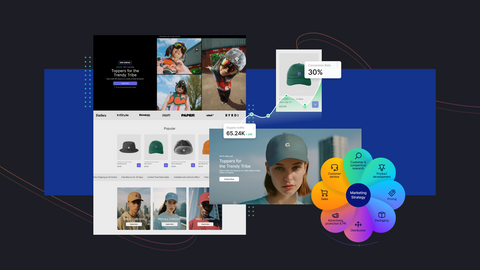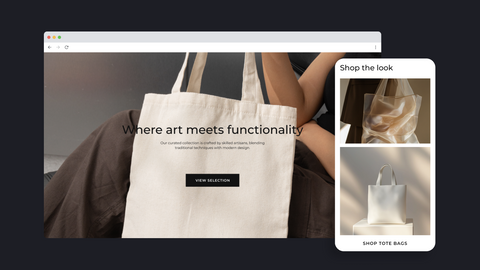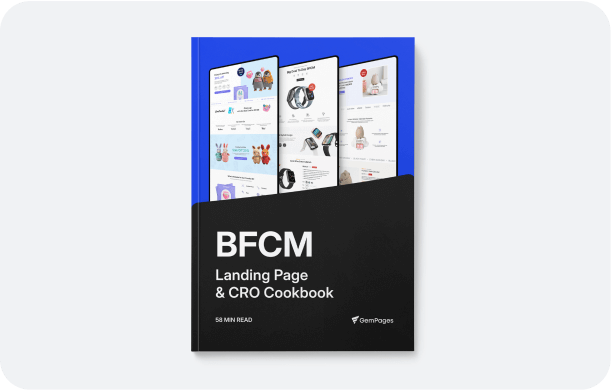- An Overview of Customer Retention
- Why does customer retention marketing matter?
- 10 Best Customer Retention Marketing Strategies
- #1. Engage customers from the first visit to your store
- #2. Focus on personalized experiences
- #3. Trigger customer attention with gamification
- #4. Offer customers quick and reliable support
- #5. Run rewarding programs for customers
- #6. Collect customer feedback often
- #7. Develop a strong online community
- #8. Ensure a seamless experience across channels
- #9. Boost your brand ratings on review sites
- #10. Provide customers with educational content
- Conclusion
- FAQs
Discover 10 Proven Customer Retention Marketing Strategies to Boost Loyalty

You have nailed your product, your ads are converting, and many customers are buying. However, here’s the million-dollar question: Are they coming back and getting products again?
Too often, many businesses pour resources into acquiring new customers while neglecting the real lever in marketing and sales: customer retention. According to Frederick Reichheld of Bain & Company, a 5% rise in customer retention can increase profits by 25% to 95%. Consequently, more sellers start to learn how to retain customers and care about retention strategies.
In this guide, we will explore everything related to customer retention and 10 proven customer retention marketing strategies that drive loyalty, reduce churn, and keep buyers coming back.
Let’s get started right now!
An Overview of Customer Retention
What is customer retention?
Customer retention is a mix of strategies and actions a brand/business/seller takes to keep its existing customers engaged, satisfied, and coming back. It’s a key part of retention marketing, focusing on turning one-time buyers into loyal customers via impressive shopping experiences.

Customer retention aims to keep current customers engaged and return to the brand
In B2C, most customer retention market strategies involve creating a smooth post-purchase journey and offering tailored promotions. In B2B, customer retention centers on building strong relationships from the initial onboarding phase, ensuring the client’s evolving demands are met.
4 Key customer retention metrics to measure in marketing
Before you can improve retention, you need to measure it accurately. Understanding how well your business retains customers provides a solid foundation for applying effective customer retention strategies in marketing. These metrics don’t just show how loyal your customers are; they also help you identify what’s working and what needs fixing in your retention activities. Below are the four key metrics that reveal the true impact that you should consider significantly.
1. Customer retention rate (CRR)
This is the standard metric for measuring how many customers stick with your brand over a specific time period. Depending on your demands, you can calculate CRR monthly, quarterly, or annually. Apparently, a high CRR is a strong sign of buyer satisfaction and product-market fit.
|
Customer Retention Rate = [(Customers at end of period - New customers acquired) / Customers at start of period] x 100 |
2. Customer churn rate (CCR)
While the retention rate tells you who stayed, the churn rate tells you who left. Once there is a high churn, it often reflects friction in your onboarding, product experience, or customer support. It’s time to re-evaluate your customer retention marketing strategies and pinpoint mistakes.
|
Customer Churn Rate = (Lost customers at end of period / Customers at start of period) x 100 |
3. Customer lifetime value (CLTV)
This metric estimates how much revenue a customer will generate over the entire duration of their relationship with your brand, helping determine which buyer segments are worth the most. Then, let’s focus on customers with high CLTV to inform targeted campaigns and maximize ROI.
|
Customer Lifetime Value = Average Order Value x Purchases per Year x Retention Rate |
4. Repeat purchase rate (RPR)
The final metric involves the percentage of your customers who are coming back for a second (or third) purchase. This is especially valuable in eCommerce, where buying cycles are shorter. Therefore, ensuring high RPRs is vital to generating a steady stream of revenue for businesses.
|
Purchase Frequency Rate = (Number of Repeat Purchase Customers / Total Number of Customers) x 100 |
Why does customer retention marketing matter?
Drive higher customer lifetime value
One of the key benefits of customer retention marketing strategies is the ability to increase Customer Lifetime Value (CLTV). When customers return to your business over and over again, their total shopping spending grows, often far exceeding that of new customers (about 67%). These customers tend to place more orders, shop more frequently, and be less price-sensitive.
Improve cost-effectiveness
Studies indicate that acquiring a new customer can cost 5 to 25 times more than retaining an existing one, and even more in specific industries. That’s when customer retention strategies in digital marketing come into play, especially in businesses that only sell on eCommerce. By leveraging tools like automated email sequences and loyalty programs, you can re-engage current buyers at a fraction of the cost, making your marketing budget work smarter, not harder.
Get more high-quality referrals
Loyal customers are the best brand ambassadors; they’re your most powerful marketing asset. Truly, they are more likely to leave glowing reviews and recommend your products to relatives.
Enhancing customer retention strategies through personalized marketing is key to nurturing this kind of loyalty, with 80% of customers preferring customized shopping journeys. When customers feel seen and valued via tailored product discounts and personalized emails, their emotional connection to your brand deepens, increasing the likelihood of organic referrals.
10 Best Customer Retention Marketing Strategies
#1. Engage customers from the first visit to your store
First impressions matter, and in eCommerce, your storefront is your first handshake. Whether offline or online, engaging customers from the first touchpoint sets the tone for the experience. In brick-and-mortar stores, this might mean friendly staff and an inviting layout that you set up. Online, it all comes down to website performance and design, and how products are displayed.

GemPages is the #1 website page builder for Shopify stores
That’s where GemPages makes a difference. As a flexible, drag-and-drop builder for Shopify, GemPages enables stunning storefronts that are optimized for both aesthetics and conversions. With customized landing pages, you can easily impress visitors to stay longer and explore more. GemPages also offers 200+ templates to help save time when designing websites from scratch.
After finishing and publicizing your Shopify store, you can take full advantage of GemPages to run A/B testing to evaluate which version works well for high conversion and select the best fit. When your store feels memorable and gets more traffic, you’re already halfway to earning a loyal customer, proving the role of store designs in customer retention marketing strategies.

#2. Focus on personalized experiences
Once again, we want to highlight personalization. In such a competitive eCommerce landscape, delivering a one-size-fits-all experience just isn’t enough. Every customer always desires to feel understood and valued, not just like another name printed on a receipt or saved in the sales system.
Sellers can start by offering dynamic product recommendations, customized emails, targeted offers, and retargeting ads based on buyers' behaviors, preferences, and purchase history. These can show customers that your brand is paying more attention to them. Consequently, they tend to return to your store, make repeat purchases, and even become brand advocates.
#3. Trigger customer attention with gamification
Gamification brings fun and motivation into your customer experience. By adding game-like features, such as points, badges, or spin-to-win rewards, you make interactions more exciting.

Gameball offers fantastic gamification when setting up reward programs in stores
For example, we can set up reward programs that unlock higher tiers or bonus perks to motivate customers to keep engaging. Some Shopify apps, like Gameball, make it easy without coding. However, you need to ensure your gamification enhances rather than disrupts the customer journey because some poorly placed pop-ups or unclear rules can cause friction and frustration.
#4. Offer customers quick and reliable support
Customer support speed and quality are non-negotiable. Any delayed or poor response can erode trust and instantly cost you your potential or current customers. That’s also why ensuring friendly, helpful service is one of the most effective customer retention marketing strategies.
Many brands start investing more in live and 24/7 chats, AI-powered chatbots, or knowledge bases to provide real-time assistance. You should set clear response time expectations publicly and train your support team, or set up your app to solve problems effectively within this duration.
#5. Run rewarding programs for customers
Loyalty programs are a common strategy for retailers, both online and offline, to turn one-time buyers into long-term customers. They can include point-based systems, exclusive discounts, cashback offers, or VIP tiers to incentivize repeat purchases and boost customer engagement. In fact, cashback is the king, with 53% of respondents voting it as their favourite type of reward.

Cashback is the most loved reward program by most customers
On the other hand, to keep your program effective, let’s make it easy to join, be transparent about how rewards are earned, and be consistent about delivering value. This will encourage future purchases, helping brands create a mutually beneficial relationship that is hard to break.
#6. Collect customer feedback often
To keep customers happy, you need to listen. Regularly collecting feedback through surveys, post-purchase emails, or review prompts helps you understand what’s working and what’s not.
Feedback gives you direct insights into customer expectations and pain points while experiencing your service. More importantly, acting on it showcases that you value their voice. This builds trust, fosters a sense of involvement, and opens the door for long-term relationships. For high-quality results, remember to make customer feedback collection easy and frictionless.
#7. Develop a strong online community
Another strategy today is to develop an online community, one of the most effective customer retention strategies in service marketing, based on the power of WOM to engage customers. Platforms like Facebook Groups, Reddit Forums, or even branded hashtags on social media can be free spaces where customers share experiences, ask questions, and support each other.

Building a customer-centered online community can help build a positive relationship
This sense of belonging builds emotional bonds with your brand, making customers feel seen, heard, and valued. It also sparks organic conversations that can influence purchasing decisions.
#8. Ensure a seamless experience across channels
Whether customers interact with your brand via website, mobile app, email, or in-store, their experience should feel connected and consistent. Omnichannel shopping experiences can build trust and remove friction, which are both essential for retaining current buyers for lasting loyalty.
You can start by aligning your messaging, design, and promotions across channels. Additionally, you need to ensure your support systems are integrated and customer profiles are all synced. When a shopper can browse on their phone and finish checkout on the desktop without issues, smooth transitions and unified experiences undoubtedly indicate that the brand is professional.
#9. Boost your brand ratings on review sites
A strong rating on platforms like Trustpilot, Google Reviews, or even your product pages increases credibility and reduces purchase hesitation. It plays a key role in customer retention. Brands can encourage satisfied buyers to leave reviews by automating requests post-purchase. Otherwise, some sellers offer incentives like discounts or reward points to boost participation.

Google reviews significantly influence brands with in-store and online sales models
Another point in this customer retention marketing strategy is to respond professionally to both positive and negative reviews. This shows that you care and are committed to improving. High ratings and transparent communication gradually establish strong trust for any relationship.
#10. Provide customers with educational content
The final customer retention strategy in marketing is providing educational content. Resources like how-to guides, tutorials, blog articles, FAQs, or short videos empower customers to get the most out of your products or services while reducing confusion and support requests. When buyers feel more confident using your offerings, they’re more likely to stay loyal and make repeat purchases. This also positions you as an expert in your industry, helping build credibility.
Conclusion
Hopefully, the 10 highly voted customer retention marketing strategies can inspire you to take a more proactive approach to building customer loyalty and reducing churn. Remember, retaining customers isn’t just about offering discounts; it’s about consistently delivering value, keeping them satisfied, and making every touchpoint meaningful enough to bring them back.
Need more tips to improve your store's performance? Visit GemPages blogs for expert insights, guides, and inspiration tailored to eCommerce success, especially for Shopify-based brands.



 Facebook Community
Facebook Community Change Log
Change Log Help Center
Help Center












